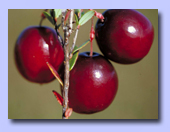|
Lesson Plan:
Overview
Background
Materials
Preparation
Step-by-Step
|
- Introduce the lesson by telling students they are going to learn about the history of the cranberry by reading “The Cranberry through Time”.
- Either in pairs, small groups, or whole class, read “The Cranberry through Time”. Discuss key associations highlighted by the reading selection. For example, the Native American used the cranberry to make a food called pemmican. (15 minutes)
- Tell the students that they are going to play a type of matching game with cards. Two students comprise a team. Opposing teams will share one deck of playing cards. Explain that each team will have its own playing board, and a sheet of writing paper. Show the materials.
- Explain the directions of the game:
- Place the Connections Playing Board in front of you. Shuffle cards and place the deck between both playing boards.
- Each team draws three cards and places them face up in a horizontal position across the board.
- Decide which team begins.
- The beginning team (A) determines if it can create a valid connection between any two of the three cards on its board. If so, that is a match. Team A must clearly articulate that connection to Team B. If no match is found among the three cards, Team A is allowed one draw from the deck to attempt to make a match. If still no match can be found, the card drawn is placed in a discard pile and Team A’s turn ends.
- Match example: Three cards are face up on the board: Native American, cannonball, pemmican. Because Native Americans used the cranberry in a food called pemmican, there is a match between 2 of the cards.
- No Match: three cards are face up on the board: Pilgrims, Henry Hall, glacier. Based on the reading selection, there is no connection between these 3 cards.
- Team B begins its turn. Allowed play: (1) a match found on the board between 2 of the 3 cards facing up; (2) a match using the discard, or (3) a match with a card drawn from the deck.
- If (when a team begins its turn) there are only 2 cards face up on the board, that team first draws one card from the deck to add to the board. The team’s turn then begins.
- If the opposing team agrees with the match, the playing team puts the matched cards aside. If the opposing team disagrees with the connection sentence, the playing team must identify where that connection can be found in the reading selection.
- If there are unresolved disputes, they will be settled in “Cranberry Court”. (Don’t assign or deduct any points yet. Valid disputes will earn points for the opposing team. Invalid one will earn point for the playing team). The playing team writes the disputed sentence on paper.
- The game is played until all cards are used or the teacher calls time. (20 minutes)
- Teams count their matches (one point per match).
- “Cranberry Court” is then in session to deal with all disputes that arose during the game. (See Lesson step #6 for description of Cranberry Court).
- Distribute one Connection Playing Board for each team, paper, and one deck of cards.
- Have students begin their game. Plan to allow 10 minutes at the end of the class for “Cranberry Court”.
- Discuss each dispute. As a whole class, decide on the validity of the disputed connection. For those matches deemed valid, the playing team is allowed two points. If the opposing team was correct in their dispute, they are awarded two points. The team that created the incorrect sentence is penalized one point.
- Wrap up the lesson with a short discussion. Ask students how playing this game added to their understanding of the reading selection.
Student Blog
You have just opened a magical can of cranberry sauce. Out pop 3 cranberries. Each transforms into a person, place, or thing. All are connected to each other through the cranberry. What do you see, and how are they connected?
|







